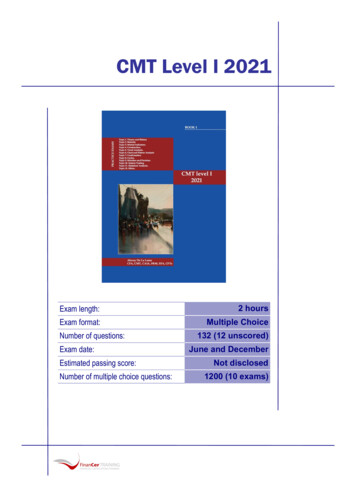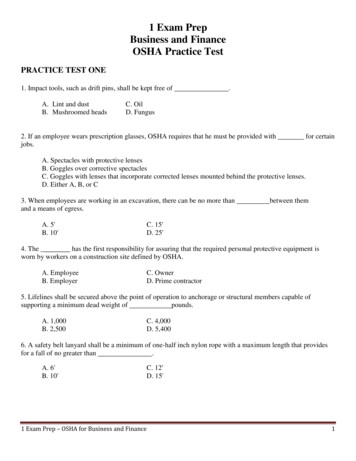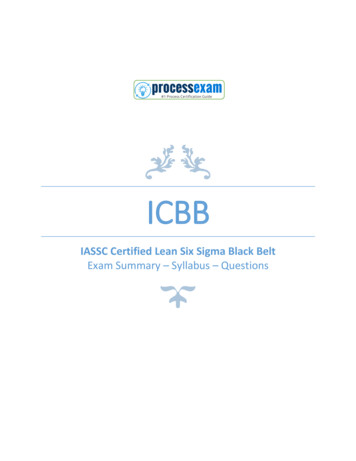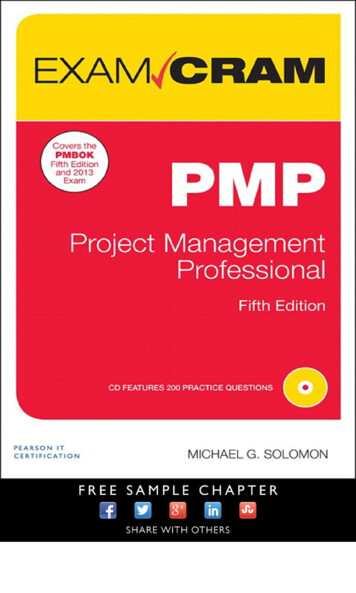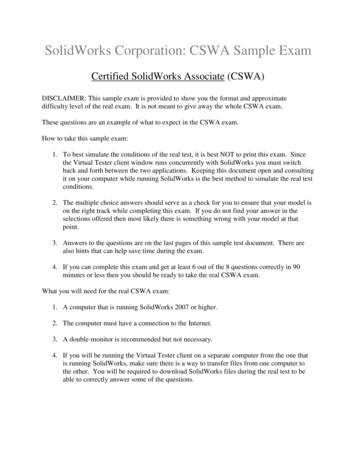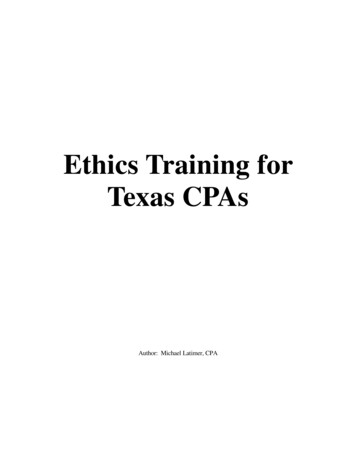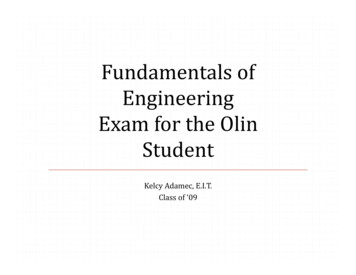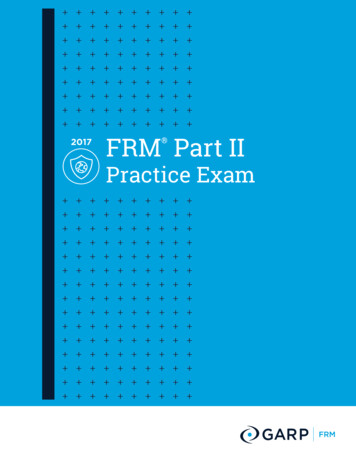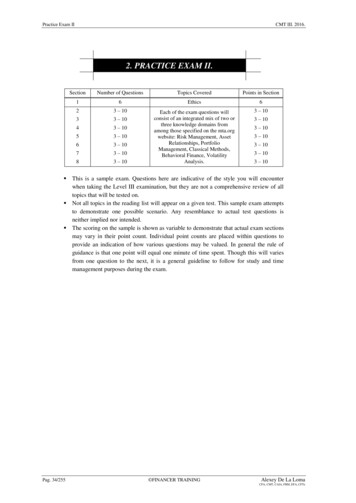
Transcription
Practice Exam IICMT III. 2016.2. PRACTICE EXAM II.SectionNumber of QuestionsTopics CoveredPoints in Section16Ethics623 – 103 – 1043 – 1053 – 1063 – 1073 – 1083 – 10Each of the exam questions willconsist of an integrated mix of two orthree knowledge domains fromamong those specified on the mta.orgwebsite: Risk Management, AssetRelationships, PortfolioManagement, Classical Methods,Behavioral Finance, VolatilityAnalysis.3 – 1033 – 103 – 103 – 103 – 103 – 103 – 10 This is a sample exam. Questions here are indicative of the style you will encounterwhen taking the Level III examination, but they are not a comprehensive review of alltopics that will be tested on. Not all topics in the reading list will appear on a given test. This sample exam attemptsto demonstrate one possible scenario. Any resemblance to actual test questions isneither implied nor intended. The scoring on the sample is shown as variable to demonstrate that actual exam sectionsmay vary in their point count. Individual point counts are placed within questions toprovide an indication of how various questions may be valued. In general the rule ofguidance is that one point will equal one minute of time spent. Though this will variesfrom one question to the next, it is a general guideline to follow for study and timemanagement purposes during the exam.Pag. 34/255 FINANCER TRAININGAlexey De La LomaCFA, CMT, CAIA, FRM, EFA, CFTe
CMT III. 2016.Practice Exam II2.1. Section 1. Ethics (12 points).1A. David Johnson, a senior analyst with a brokerage firm, decides to change his recommendation forthe common stock of Pigeon Industries, Inc. from a “buy” to a “sell”. This change in investmentadvice is mailed to all the firm’s clients on Wednesday. Next day, a client calls in with a buy orderfor 500 shares of Pigeon Industries, Inc. In this circumstance, Johnson should: (2 points)a) Accept the order.b) Advise the customer of the change in recommendation after accepting the order.c) Advise the customer of the change in recommendation before accepting the order.d) Not accept the order because it is contrary to the firm’s recommendation.1B. The mosaic theory holds that an analyst: (2 points)a) Violates the Code and Standards if the analyst fails to have knowledge of and comply with theapplicable laws.b) Can use material public information and nonmaterial nonpublic information in the analyst’sanalysis.c) Should use all available and relevant information in support of an investment recommendation.d) Can use material and nonmaterial nonpublic information in the analyst’s analysis.1C. Bell is a portfolio manager. One of his firm’s clients has told Bell that he will compensate himbeyond the compensation provided by his firm on the basis of the capital appreciation of hisportfolio each year. Bell should: (2 points)a) Accept the arrangement before obtaining permission from his employer.b) Obtain permission from his employer prior to accepting the compensation arrangement.c) Turn down the additional compensation because it will create undue pressure on him to achievestrong short-term performance.d) Turn down the additional compensation because it will result in conflicts with the interests of otherclient’s accounts.1D. Which of the following is a correct statement of a member’s or candidate’s duty under the Codeand Standards? (2 points)a) In the absence of specific applicable law or other regulatory requirements, the Code and Standardsgovern the member’s or candidate’s actions.b) A member or candidate is required to comply only with applicable local laws, rules, regulations, orcustoms, even though the Code and Standards may impose a higher degree of responsibility or ahigher duty on the member or candidate.c) A member or candidate who trades securities in a market where no applicable laws or stock exchangerules regulate the use of material nonpublic information may take investment action based on materialnonpublic information.d) A member or candidate who trades securities in a market where stock exchange rules permit the use ofmaterial nonpublic information may take investment action based on material nonpublic informationafter obtaining prior approval from his/her supervisor.Alexey De La LomaCFA, CMT, CAIA, FRM, EFA, CFTe FINANCER TRAININGPag. 35/255
Practice Exam IICMT III. 2016.1E. Elizabeth is a financial analyst with XYZ Brokerage Firm. She is preparing a purchaserecommendation on JNI Corporation. Which of the following situations is most likely to representa conflict of interest for Elizabeth that would have to be disclosed? (2 points)a) Elizabeth’s brother-in-law is a supplier to JNI.b) Elizabeth frequently purchases items produced by JNI.c) XYZ holds for its own account a substantial common stock position in JNI.d) Elizabeth’s experience with purchasing items produced by JNI has been extremelypositive.supervisor.1F. Which of the following is not a category listed among the standards of professionalism in the CFAStandards of Professional Conduct? (2 points)a) Knowledge of the Lawb) Independence and Objectivityc) Misconductd) Fairness.Pag. 36/255 FINANCER TRAININGAlexey De La LomaCFA, CMT, CAIA, FRM, EFA, CFTe
CMT III. 2016.Practice Exam II2.2. Section 2 (20 - 40 points).You are a macro and momentum fund manager for Omega Investment Partners, and you are in chargeof 3 funds (Alpha, Beta and Gamma) focused on the U.S. markets from a long-term perspective. Inorder to achieve your conclusions you have gathered the following charts: Figure 2-1 shows the totalcommercial and industrial loans along with the total consumer credit for the U.S. economy from 1982to 2012. Figure 2-2 illustrates a montly bar chart or the S&P 500 from 2000 to 2015 along with a21-monthly exponential moving average. Table 2-1 illustrates the performance of all these funds.Source: Federal Reserve Economic Database.Alexey De La LomaCFA, CMT, CAIA, FRM, EFA, CFTeFigure 2-1 FINANCER TRAININGPag. 37/255
Practice Exam IICMT III. 2016.Source: www.stockcharts.com.Figure 2-2Fund AlphaFund BetaFund GammaPercent profitable30.5%56.6%59.4%10-year average annual return15.7%8.2%9.3%Standard deviation of annual orrelation coefficient with the S&P-500 index0.58-0.120.45Sharpe e beta of stocks in fundCovariance with the S&P-500 indexMax DrawDown (MaxDD)Information ratio based on 10-year average returnSource: Own Elaboration.Table 2-12A. Figure 2-1 shows the total commercial and industrial loans along with the total consumer creditfor the U.S. economy from 1982 to 2012. Determine whether this economic indicator is leading,coincident, or lagging. Explain how to use it, and illustrate, briefly, the implications for the U.S.economy. (8 points)2B. Figure 2-2 illustrates a monthly bar chart or the S&P 500 from 2000 to 2015 along with a21-monthly exponential moving average. Determine a basic recommendation about the timeframeused in this chart. (8 points)Pag. 38/255 FINANCER TRAININGAlexey De La LomaCFA, CMT, CAIA, FRM, EFA, CFTe
CMT III. 2016.Practice Exam II2C. Figure 2-2 illustrates a monthly bar chart or the S&P 500 from 2000 to 2015 along with a21-monthly exponential moving average. Determine the long-term trend of this equity index. Baseyour analysis in the technical indicator. (8 points)2D. According to Table 2-1 determine which fund has a higher total risk. (7 points)2E. According to Table 2-1 determine which fund has a higher systematic risk. (7 points)Alexey De La LomaCFA, CMT, CAIA, FRM, EFA, CFTe FINANCER TRAININGPag. 39/255
Practice Exam IICMT III. 2016.2.3. Section 3 (20 - 40 points).You are a hedge fund manager working for a money management firm and you are responsible forfour hedge funds (Alpha, Beta, Gamma, and Delta). All four funds invest in equity taking both longand short positions. In a meeting with potential clients you show them the main characteristics of theseinvestment vehicles. Figure 2-3 illustrates a relative rotational graph showing the main ten sectors ofthe securities’s universe included in your investment vehicles with a short trailing period of 3 weeks.Figure 2-4 illustates a relative rotational graph of four stocks (A, B, C, and D) that are potentialcandidates for hedge fund Gamma with a long trailing period of 14 weeks. Table 2-2 illustrates thecomparison between the portfolio of stocks included in hedge fund Delta and their benchmark (SPDRETFs).Leading104ImprovingB102A100ICF98JdK RS-MomentumDE96HGJLaggingWeakening9698100102104JdK RS-RatioSource: Own Elaboration.Pag. 40/255Figure 2-3 FINANCER TRAININGAlexey De La LomaCFA, CMT, CAIA, FRM, EFA, CFTe
CMT III. 2016.Practice Exam IILeadingStock D100Stock A98Stock B96JdK RS-Momentum102104ImprovingStock CLaggingWeakening9698100102104JdK RS-RatioSource: Own Elaboration.Figure 2-4SectorSectorReturnWeightedSector ReturnPortfolioReturnWeightedPort. %1.68%0.08%Telecommunication 13%2.48%Information %0.54%9.00%0.49%-0.05%Consumer Staples15.40%2.37%20.80%3.20%0.83%Consumer 00%0.42%-0.56%12.28%3.00%9.28%9.44%12.32%Source: Robert WeigandAlexey De La LomaCFA, CMT, CAIA, FRM, EFA, CFTeTable 2-2 FINANCER TRAININGPag. 41/255
Practice Exam IICMT III. 2016.3A. A relative rotational graph (RRG) is a scatter diagram used to see the situation and evolution ofdifferent sectors, stocks, currencies, funds, etc. Paul Ciana created these charts and he uses twoproprietary indicators, a relative strength momentum, and a relative strength ratio to classifysectors into four quadrants (weakening, lagging, improving, and leading). In Figure 2-3 the tensectors are classified according to this type of graph. Determine the correct sentence. (4 points)a) Sector A is in the top-right quadrant. Elements in this quadrant have positive relative strength andpositive momentum, which means that the RS is still getting stronger.b) Sector E is in the bottom-right quadrant. Elements in this quadrant have positive relative strength andpositive momentum, which means that the RS is still getting stronger.c) Sector H is in the bottom-left quadrant. Elements in this quadrant have positive relative strength andpositive momentum, which means that the RS is still getting stronger.d) Sector I is in the top-leftt quadrant. Elements in this quadrant have positive relative strength andpositive momentum, which means that the RS is still getting stronger.3B. Determine the better candidates for a long or an overweight position from the ten sectorsillustrated in Figure 2-3. (11 points)3C. Determine the best candidate for a long position in hedge fund Gamma from the four stocksillustrated in Figure 2-4. (9 points)3D. Taking the performance attribution study illustrated in Table 2-2, determine the portfolio weightsof Energy and Industrials. (8 points)3E. Taking the performance attribution study illustrated in Table 2-2 determine whether the sectorallocation and the stock picking strategies for hedge fund Delta are positive or negative, andexplain your answer. (8 points)Pag. 42/255 FINANCER TRAININGAlexey De La LomaCFA, CMT, CAIA, FRM, EFA, CFTe
CMT III. 2016.Practice Exam II2.4. Section 4 (20 - 40 points).You are the head of a department in charge of managing mutual and hedge funds for LahkswredInvestment Partners. Your company has hired 10 fund manager trainees and you are going to spend 2weeks training them about the company culture and the management methods employ in yourdepartment. During this 2-week training program some relevent questions arise about momentummyths and behavioral finance.4A. One of the trainees usually refers to trading methods that neglect small risk, ignoring all riskspositioned between the extremes. You know that most people have a tendency to overstate theprobability of events in which they have a large bank of relevant memories, and you tell yourtrainees that this bias is known as the: (6 points)a) Representativeness bias.b) Conjunction fallacy.c) Small sample bias.d) Probability neglect bias.4B. When you explain in detail the momentum strategies used by your firm to manage some of themutual funds, one of the trainees asks why you are using momentum strategies on the long side ifthis kind of strategies can only be exploited on the short side. Is this commentary correct? (14points)4C. When you explain in detail how your department manages these funds, you mention that in themorning investment committee all fund managers use a brainstorming process to decide the mainaction for the rest of the day. However, you warn your trainees that this kind of groups, in orderto be an efficient device must meet three relevant conditions. Could you name, at least, two ofthese three conditions? (14 points)Alexey De La LomaCFA, CMT, CAIA, FRM, EFA, CFTe FINANCER TRAININGPag. 43/255
Practice Exam IICMT III. 2016.2.5. Section 5 (20 - 40 points).You work as a hedge fund manager for a big investment company and you are responsible for threehedge funds: hedge fund ALPHA, which is based on a long-only strategy based on U.S. and Europeanstocks; hedge fund BETA, which is based on a long-only strategy based on European fixed-incomesecurities. No leverage is allowed in this fund; and hedge fund GAMMA, which is mainly invested incommodity futures and it benefits from leverage and from long and short positions. You are studyingthe time series of Bank of America in order to add this security to one of your hedge funds. You havegathered the following information: Figure 2-5 illustrates in the upper window the ratio between BAKand the S&P-500 index in a line format from June 2012 to October 2015. In the lower window, thesame period and format illustrates the S&P-500 index alone. Table 2-3 s
CMT III. 2016. Practice Exam II Alexey De La Loma FINANCER TRAINING Pag. 35/255 CFA, CMT, CAIA, FRM, EFA, CFTe 2.1. Section 1. Ethics (12 points). 1A. David Johnson, a senior analyst with a brokerage firm, decides to change his recommendation for the common stock of Pigeon Industries, Inc. from a “buy” to a “sell”. This change in investment
